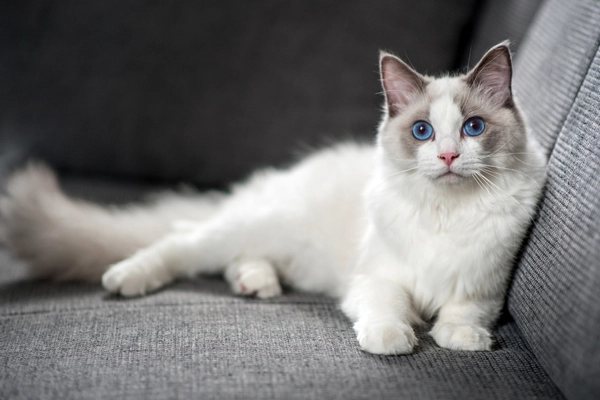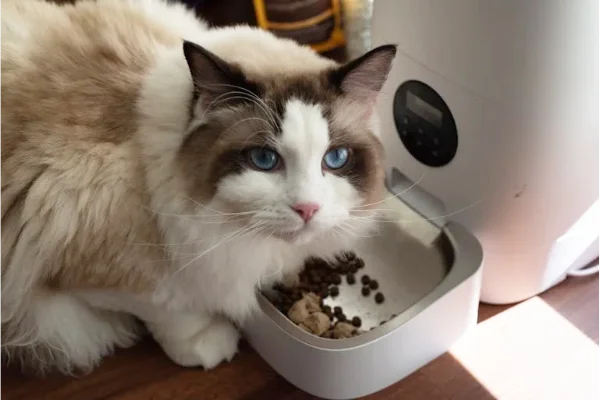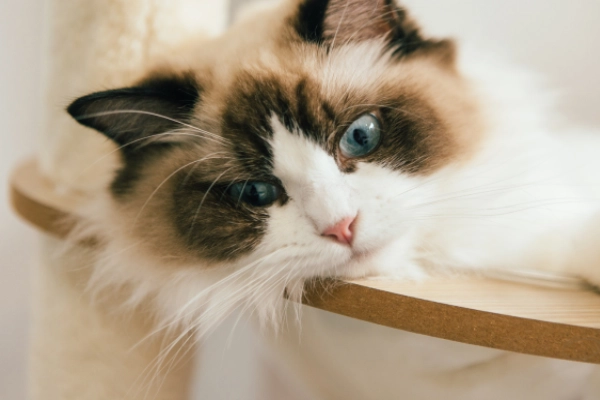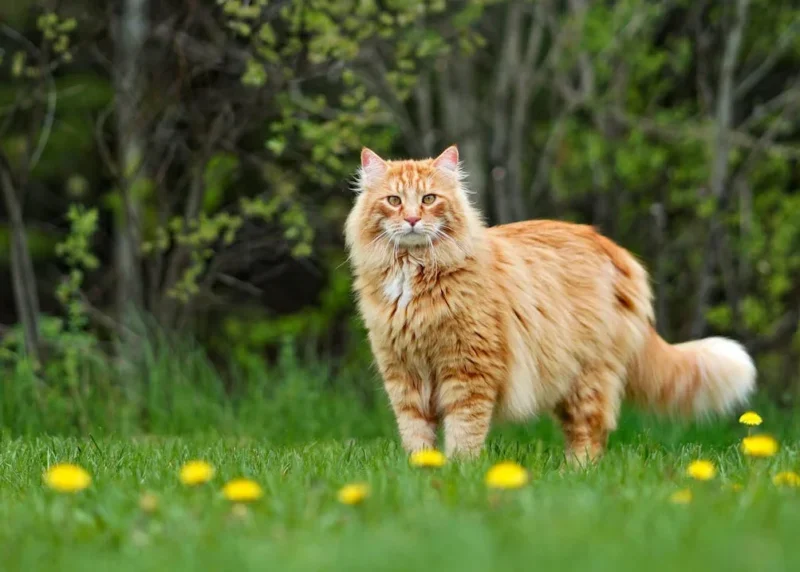
We may earn a commission when you purchase via our links at no extra cost to you.
We only share resources that meet our high standards
Introduction
Ragdoll cats are often called the “gentle giants” of the feline world. With their striking blue eyes, semi-long silky coats, and famously relaxed temperament, they are one of the most popular cat breeds among families and first-time pet owners. Ragdoll cat personality are affectionate without being overbearing, playful without being destructive, and social without being demanding.
If you’re considering bringing one of these sweet-natured cats into your home, it’s important to understand not just their personality, but also their history, daily care needs, health concerns, and financial costs. This in-depth guide will walk you through everything you need to know to decide whether a Ragdoll cat is the right companion for you.
Ragdoll Cat Breed History

The Ragdoll breed has a fascinating origin story. Unlike many breeds that trace back centuries, Ragdolls are relatively new, developed in the 1960s in Riverside, California.
A breeder named Ann Baker started with a white longhaired domestic cat named Josephine. Josephine had a unique tendency to go limp when picked up—relaxing completely in a person’s arms. Baker selectively bred Josephine’s kittens with other cats that shared this docile personality, and over time, she established the foundation for the Ragdoll breed.
By the 1970s and 1980s, Ragdolls gained wider recognition. Today, they are registered with major organizations like the Cat Fanciers’ Association (CFA) and The International Cat Association (TICA). They consistently rank among the top five most popular cat breeds in the U.S. and Europe.
Fun fact: The name “Ragdoll” comes from their tendency to flop like a ragdoll when picked up—a trait that still delights owners today.
Ragdoll Cat Personality Traits
Ragdolls are often described as “puppy-like” cats because they form strong bonds with their humans and often follow them from room to room. They are one of the few cat breeds that genuinely enjoy being held and carried, making them a favorite among children and seniors.
What Makes Ragdolls Unique?
- Affectionate & Gentle
They are loving companions that thrive on attention but are not overly demanding. Many will curl up beside you for hours. - Sociable & Friendly
Ragdolls typically get along well with children, dogs, and other cats. Their even temperament makes them a great choice for multi-pet households. - Relaxed & Easygoing
Unlike more vocal or anxious breeds (like Siamese), Ragdolls adapt well to changes in their environment. - Playful but Balanced
While they enjoy feather wands, puzzle feeders, and interactive toys, they are not hyperactive. They’re equally happy lounging by your side.
Personality Comparison Table
| Breed | Personality Highlights | Energy Level | Affection Level |
|---|---|---|---|
| Ragdoll | Gentle, affectionate, social | Medium-Low | Very High |
| Maine Coon | Playful, intelligent, independent | Medium-High | High |
| Siamese | Vocal, attention-seeking, active | High | High |
👉 Related: Maine Coon Cats: Gentle Giants of Felines
Caring for a Ragdoll Cat

Though Ragdolls are relatively easy to care for, their size and coat do require attention. Here’s what owners should plan for:
Diet & Nutrition
Ragdolls are large cats, with males weighing 15–20 pounds and females 10–15 pounds. They are prone to obesity, so it’s important to measure portions and avoid overfeeding.
- Best diet: High-protein, grain-free food, with a mix of wet and dry to support hydration and dental health.
- Feeding schedule: 2–3 small meals per day to prevent overeating.
- Monthly cost: $40–$70 for premium cat food.
Tip: Choose foods that include taurine, an essential amino acid for cats that supports heart and eye health.
Grooming Needs
Despite their long coat, Ragdolls have minimal undercoat, which means less matting compared to Persians. However, grooming is still essential:
- At-home grooming: Brush 2–3 times per week using a slicker brush or steel comb. This reduces shedding and prevents hairballs.
- Bathing: Not always necessary, but occasional baths can help during shedding season.
- Professional grooming: Every 2–3 months if preferred. Cost: $50–$80 per session.
Tip: Start grooming routines early—Ragdolls usually enjoy being brushed if introduced as kittens.
Exercise & Enrichment
Although calm, Ragdolls still need daily activity to prevent obesity. Provide climbing trees, scratching posts, and 15 minutes of playtime twice a day.
Bonding & Training
Ragdolls respond well to positive reinforcement. Many can be trained to:
- Walk on a leash
- Play fetch
- Use puzzle feeders
Because they’re so people-oriented, they thrive when included in family routines.
Adoption Price & Cost of Ownership
Before adopting a Ragdoll, it’s essential to consider both the initial adoption price and ongoing care costs.
Initial Adoption Price
- Shelters & rescues: $100–$300 (rare, as purebred Ragdolls are not often surrendered)
- Breeders: $1,000–$2,500 depending on pedigree, color pattern, and whether the cat is pet-quality or show-quality
Ongoing Costs
- Food: $500–$800 annually
- Grooming: $50–$100 for supplies (brushes, nail clippers) or $200–$400 annually for professional grooming
- Veterinary Care:
- Vaccinations: $100–$200 in the first year, $50–$100 annually after
- Spay/neuter: $200–$500 if not included in adoption
- Annual exams: $150–$300 each year
- Emergency care/insurance: $30–$60 per month for coverage
- Other Costs: Litter ($150–$250 annually), toys, scratching posts, and beds ($100–$200 annually)
Cost Breakdown Table
| Expense | First Year | Annual Ongoing |
|---|---|---|
| Adoption/Purchase | $100–$2,500 | — |
| Food | $500–$800 | $500–$800 |
| Grooming | $50–$400 | $200–$400 |
| Vet Care + Vaccines | $300–$600 | $200–$400 |
| Misc. (litter, toys) | $200–$400 | $200–$400 |
| Total | $1,150–$4,700 | $1,100–$2,000 |
Owning a Ragdoll is a long-term commitment, both emotionally and financially.
Common Health Issues in Ragdoll Cats
Like many purebred cats, Ragdolls are predisposed to certain conditions. Responsible breeders screen for these, but owners should still be aware.
- Hypertrophic Cardiomyopathy (HCM): The most common heart disease in cats. Genetic testing can reduce risk.
- Polycystic Kidney Disease (PKD): Leads to kidney cysts and potential kidney failure. Early screening is key.
- Bladder Stones & Urinary Issues: More common in cats with poor hydration—encourage wet food and fresh water.
- Obesity: A preventable issue that shortens lifespan and increases risk for diabetes and joint problems.
With proper care, Ragdolls live an average of 12–17 years, and many reach their late teens. You also could check the feline health reference on Cornell University College of Veterinary Medicine
Is a Ragdoll Cat Right for You?
Ragdolls are a fantastic choice for many households, but they aren’t ideal for everyone.

Best Suited For:
- Families with children (gentle and tolerant)
- Seniors seeking a calm companion
- First-time cat owners (easygoing nature)
- Apartment living (adaptable to indoor-only life)
Not Ideal For:
- People who want very independent cats
- Owners away from home for long hours daily
- Those not ready for grooming and vet costs
👉 Looking for a more independent but equally affectionate cat? Check out the Maine Coon guide.
FAQs About Ragdoll Cat Personality & Care
What is the personality of a Ragdoll cat?
Ragdoll cats are affectionate, gentle, and family-friendly. They are calm, enjoy being held, and adapt well to households with children and pets.
Are Ragdoll cats clingy or independent?
Ragdolls are affectionate and like being near people but are not excessively needy. They enjoy companionship without demanding constant attention.
Do Ragdolls get along with dogs?
Yes. Ragdolls are generally friendly and tolerant, making them a good match for calm, cat-friendly dogs.
How much does it cost to adopt and care for a Ragdoll cat?
Adoption from a shelter may cost $100–$300, while breeders charge $1,000–$2,500. Annual care costs average $1,100–$2,000 including food, grooming, and veterinary care.
Do Ragdoll cats need a lot of grooming?
Ragdolls need brushing 2–3 times per week to prevent tangles. Professional grooming every few months is optional but helps with coat maintenance.
What health problems are common in Ragdolls?
The most common health concerns in Ragdolls include hypertrophic cardiomyopathy (HCM), polycystic kidney disease (PKD), bladder issues, and obesity.
Key Takeaways
- Ragdolls are affectionate, gentle, and well-suited for families.
- They require regular grooming, portion-controlled diets, and vet visits.
- Expect to spend $1,100–$2,000 per year on care.
- Common health concerns include HCM, PKD, and obesity.
- With proper care, they can live 12–17 years as loyal companions.
Conclusion
The Ragdoll cat is a breed unlike any other: affectionate, calm, and people-oriented. From their fascinating California origins to their reputation as one of the most gentle cat breeds, Ragdolls have captured hearts worldwide.
While their personality makes them nearly irresistible, prospective owners should be prepared for grooming, health monitoring, and ongoing expenses. For those ready to make the commitment, Ragdolls return the investment with years of companionship, love, and quiet loyalty.
If you’re looking for a cat that will curl up beside you, greet you at the door, and fit seamlessly into family life, the Ragdoll may just be the perfect pet.

